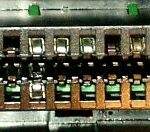The OBD2 adapter, also known as a J1962 adapter, is a critical component for vehicle diagnostics. This 1-meter, 16-pin cable connects your vehicle’s OBD2 port to a diagnostic device, such as the USB-Link™ 2 or USB-Link™ 3. This specific adapter does not support DoIP. Let’s explore its function and importance.
Understanding the OBD2 Adapter’s Role
The OBD2 adapter acts as a bridge, facilitating communication between your vehicle’s onboard computer and a diagnostic tool. By plugging into the standardized OBD2 port, typically located under the dashboard, the adapter allows access to a wealth of diagnostic information. This data enables mechanics and car enthusiasts to identify and troubleshoot vehicle issues efficiently. The 1-meter length provides ample reach, making it convenient to connect even in tight spaces.
Key Benefits of Using an OBD2 Adapter
An OBD2 adapter offers several key benefits:
- Accurate Diagnostics: A reliable connection ensures accurate data transmission, leading to precise diagnoses of vehicle problems.
- Efficient Troubleshooting: Quick access to diagnostic trouble codes (DTCs) and other data streamlines the troubleshooting process.
- User-Friendly Design: The standardized 16-pin connector ensures compatibility across a wide range of vehicles and diagnostic tools.
- Enhanced Flexibility: The 1-meter cable length provides convenient access to the OBD2 port, regardless of its location in the vehicle.
Why an OBD2 Adapter is Essential for Your Toolkit
For anyone who owns a vehicle or works in automotive repair, an OBD2 adapter is indispensable. It empowers you to:
- Monitor Vehicle Health: Regularly check for potential issues and address them proactively, preventing costly repairs down the line.
- Perform DIY Repairs: Diagnose and fix minor problems yourself, saving money on mechanic fees.
- Understand Your Vehicle Better: Gain insights into your vehicle’s performance and identify patterns that may indicate underlying problems.
- Improve Fuel Efficiency: By identifying and addressing issues that impact fuel consumption, you can optimize your vehicle’s efficiency.
How the OBD2 Adapter Works
The process is straightforward: simply connect one end of the OBD2 adapter to your vehicle’s OBD2 port and the other end to your compatible diagnostic device. The adapter establishes a secure connection, allowing the device to retrieve diagnostic data from the vehicle’s computer. This data is then interpreted by the diagnostic software, providing valuable insights into the vehicle’s health and performance.
Conclusion
The OBD2 adapter is a fundamental tool for vehicle diagnostics, providing a simple yet powerful way to access crucial vehicle information. Its ability to facilitate accurate diagnostics, enable efficient troubleshooting, and empower vehicle owners makes it an essential component for anyone involved in automotive maintenance and repair. An OBD2 adapter is a small investment that can pay significant dividends in terms of vehicle reliability and cost savings.


